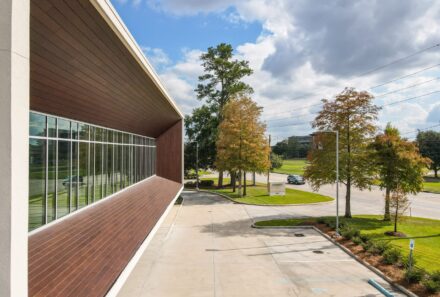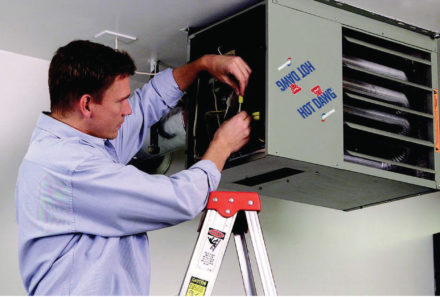What the HVAC?! Bat Cave
Holy HVAC, Batman!
Heating, ventilation, and air conditioning, or HVAC, is the technology of indoor environmental temperature and humidity control. Its goal is to provide thermal comfort and acceptable indoor air quality. HVAC system design is based on the principles of thermodynamics, fluid mechanics, and heat transfer, and often includes refrigeration. To put it simply, it’s heating and cooling a place. Buildings have heat for the cold months and A/C for the hot ones. We know how those things work, for the most part. If you’re chilly, you have that brief internal debate about whether or not to put on a sweater or just crank up the thermostat. And when it’s that
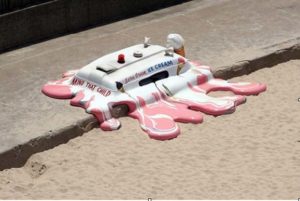
sort of Summer hot that feels like you’re getting slapped in the face with a wet blanket every time you leave the house, you pump that A/C up to give yourself the pleasure of the Arctic while the sidewalk melts.
Pretty standard stuff.
And also not nearly as interesting as discussing HVAC with far more exciting structures, like the Batcave, the subterranean base of operations for Gotham City’s most enigmatic billionaire, Bruce Wayne, AKA Batman.
We recently sat down with a number of Modine’s engineers and asked them what it would take to heat/cool famous buildings from movies, beginning with the Batcave — specifically, Christian Bale’s Batcave as seen in Christopher Nolan’s Batman Begins (2005) and The Dark Knight Rises (2012). The lair is built beneath Wayne Manor (estimated at 42,500 square feet) and is accessible courtesy of an elevator shaft originally designed by the Wayne family for the Underground Railroad (because the Wayne family has always been heroic), as well as through an open cave mouth masked by a flowing waterfall (the perfect conversation piece at all vigilante cocktail parties).

Other incarnations of the Batcave have seen everything from fully developed modern structures and facilities with walls and floors and combat training areas to practically Star Trek levels of technology to completely made of LEGO’s, but Bale’s Batcave remains quite cave-like. This allows us to make assumption on temperature and moisture common with many caves.
Though the Christopher Nolan films were filmed in Chicago and Pittsburg, many comic book enthusiasts suggest Gotham City is located in the DC Universe’s New Jersey, meaning outside the cave, there would be four seasons similar to other New England cities. In New Jersey, caves tend to maintain an average temperature of around 52 degrees Fahrenheit. Just the sort of temperature that would have Bruce telling Alfred to crank up the heat. Also, because it is a cave, there would be a relatively high amount of humidity, especially with that fully flowing waterfall rushing 24-7. The water vapor in the air would make the humidity levels very high.
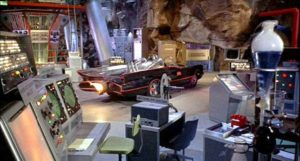
In order to keep his fancy gadgets, such as the Batmobile, Batjet, or Batcomputer operating at optimal efficiency, there would have to be a level of temperature and humidity control to ensure that they do not fail. For an electronics assembly facility, it’s recommended that the humidity remains between 35-65% with a temperature in the range of 70-77 degrees Fahrenheit.
Now, it’s safe to assume that money is no object for playboy billionaire Bruce Wayne. Let’s also assume he would pay a premium for anonymity. Knowing what we know about the temperature and humidity restrictions and the requirements of what Batman needs to properly run his hideout, what would it take to provide HVAC for the infamous Batcave?
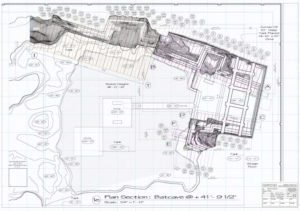
The crack team of Engineers from Modine had quite a few additional items to take into account when heating and cooling Bruce’s clubhouse. The cave has a large indoor air quality issue; high humidity, temperature control issues, and potential for Radon gas, not to mention the ample supply of bat droppings, which I’m sure just makes the whole place smell fantastic.
Some larger issues the team discussed were figuring out the total volume of the space. Without having an exact measurement on the height of the cave, we ended up assuming it is approximately 50ft in height. The computers, servers, and machinery are going to be giving off heat. Figuring out how much heat was being generated would determine if we would need to cool them or compensate and reduce the heating load of the rest of the space. And finally, humidity and technology don’t mix well, as we all know from how often we’ve all knocked over our juice boxes onto our laptops… No? Just me?… Well, to keep the humidity from frying the tech like a spilled juice box, we would have to dehumidify the cold and clammy cave, which will actually help make it more inhabitable for Bruce, in or out of his Batjamas.
With all those items taken into consideration, as well as volume to determine rate of air changes for ventilation (2 changes/hr was suggested by Alfred, who we found out started his career as an HVAC Consulting Engineer) , and meeting IAQ through compliance with ASHRAE Standard 62.1, the Engineers were able to come up with an estimate of what it would take to heat and cool Bruce’s super lair. The rule of thumb for 100% outside air ventilation is 200 CFM/ton (cubic feet per minute per ton. This means we would need to vent 354 tons based on the cubic feet in the space. Since each Atherion D cabinet can vent 60 tons, we would need 6 Units operating at 11,800 CFM each. (Follow that math?) This would take care of the venting and dehumidification.
With the ventilation load handled capably by the Atherion units, next was the actual space conditioning.…which would possibly mean utilizing return air only ground source SchoolMate units. Because these units are return air only, they would cause no complications to our venting solution and could be placed anywhere in the cave. The engineers also decided since we would be pumping in cold air from the environment, we should add some infrared heat. This is high intensity, so you don’t have to vent it. We would place the infrared heaters in strategic locations to allow for Batman and Alfred’s comfort in spaces they normally work in. The rest of the space wouldn’t need to be heated, and we wouldn’t have to worry about cooling the servers, because the general temp of the place, except under the infrared heaters, would be around 52 degrees.
The next item up for discussion was discretion. Unlike another superhero who masks his alter ego with the clever uses of glasses, Batman’s identity is not public knowledge. With all of these units controlling the temperature of the cave, we would need to hide the large Atherion ventilation units, and that would be a simple matter of wrapping them in Camo.

In the end, heating and cooling the Batcave has proved to be a task the Engineers at Modine were able to tackle with ease by determining the parameters of the space and the environmental conditions. And if he were looking for a new sidekick, every one of the interviewed folks knew every word to Prince’s Batdance, one of them carried Bat Shark Repellent, and at least one of them was willing to don the Robin costume.
NEXT TIME: Renaissance painters and pizza!


